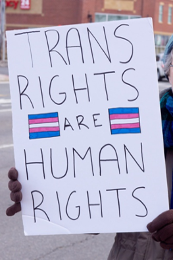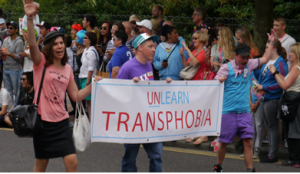11 Transphobia: Sports, Society, and Activism
Jessica Ico and Kellina Pittman
Racing down the final hill using her every last bit of strength, Michelle Dumaresq, a transgender athlete, claims victory at the 2001 British Columbia Cup event. In her second race, she did the same thing. In her third race, after beating every pro but one, women started to get angry, including two of Dumaresq’s former mentors. Several racers filed complaints with Cycling B.C., which resulted the suspension of Dumaresq’s license (Crary, 2019). Talk about sore losers. A few months later in 2002, the Union Cycliste Internationale reissued her license based on the fact that her official B.C. birth certificate reads ‘female’. Despite the petitions and protests signed and requested by fellow cyclists, all initiatives to remove Dumaresq were denied. Dumaresq continued to face transphobia when her opponent Danika Schroeter, who had come second to Dumaresq in 2006, donned a t-shirt saying “100% Pure Woman Champ.” Dumaresq recalled, “that was the moment I stopped loving sport… that kind of wrecked it for me” (Crary, 2019). To make someone stop loving the thing they once dedicated their life to is unacceptable. Just because someone is transgender, you are going to humiliate them and diminish their accomplishments? After the sporting world both inhibited and promoted Dumaresq’s participation, this goes to show that we can do better. We need to do better. Both individually, by being accepting, inclusive advocates in society, and structurally, through the policies in sport and society.
Introduction to Gender and Transphobia
Transphobia is the prejudice and discrimination against people who are transgender, and it can manifest in a multitude of ways including disbelief/disregard for their preferred name and/or pronouns, degrading language, harassment or violence (Planned Parenthood, 2020). Before we get into the gritty details, the goal of this chapter is to raise awareness about this incredibly important issue, as respectfully as possible, while promoting social change. We want to acknowledge that we both identify as cisgender women and recognize that we have never personally experienced discrimination based on our gender identity alone. While being advocates for equity for all, as well as being allies of the LGBTQ+ community, it is not our intention to speak for those who are transgender.
Let’s backpedal momentarily to discuss gender, sex, and gender identity. While the terms ‘gender’ and ‘sex’ are commonly used interchangeably, they actually have very different meanings (Government of Canada [GOC], 2020). Sex is characterized as male or female referring to biological characteristics, including reproductive anatomy, hormone levels and function, and chromosomes (GOC, 2020). As opposed to sex, gender is a social construct that can determine societies’ expectations for a person’s behaviours and self-expression (GOC, 2020). A social construct is an idea that is both created by people and accepted by society (Merriam-Webster, 2020). Furthermore, gender identity is not just binary (ie. not simply men/women), rather, it is a continuum that can change throughout one’s life (GOC, 2020). If someone is cisgender, their gender identity aligns with the sex they were assigned at birth. For example, someone assigned female at birth and who identifies as a girl/woman would be considered cisgender (American Psychological Association [APA], 2015). Transgender people have a gender identity that does not align with the sex they were assigned at birth, for instance, someone who was assigned female at birth who identifies as a boy/man (APA, 2015). We believe it is crucial to note that there are other gender identities than cisgender and transgender, but for this chapter we focus on people who identify as transgender.
Transphobia in Sport
In many aspects of sport, transgender people have been experiencing stigma, discrimination, or prejudice as a consequence of their gender identity. The question as to whether transgender athletes can compete according to their gender identity has been raised, especially due to concerns around testosterone as a possible athletic advantage in both cisgender and transgender individuals (Jones et al., 2017). In 2004, the International Olympic Committee (IOC) allowed transgender people who have transitioned after puberty to compete in sport in line with their gender identity, so long as they have had gender-confirming surgery, show legal recognition of their gender, have been prescribed cross-sex hormone treatment for at least two years, and have lived in their experienced gender for the same amount of time (Jones et al., 2017). This now rescinded 2004 policy, however, did not include transgender people who choose not to have a gender-confirming surgery (perhaps due to health risks, cost, etc.), nor did it include those who were in the process of transitioning (Jones et al., 2017). As of 2015, the IOC still has regulations in place for transgender athletes, requiring transgender women to meet several criteria in order to compete, unlike transgender men, who are able to compete in the male category without any restrictions (Mosier, 2020). These discriminatory policies about trans participation are just the tip of the iceberg and extend far beyond the sport world.
How Does Transphobia Affect Transgender People?

It’s not hard for us to imagine that transphobia has many negative impacts on transgender individuals. Trans people can experience microaggressions, discrimination, victimization, have their self-esteem diminished, as well as be at a higher risk of experiencing sexual violence (Austin & Goodman, 2016). In an article by Kate Lyons, a transgender woman from Wales, Jenny-Anne Bishop, is quoted: “I had one job where they got rid of me and they wrote to every company I applied to and said: ‘Don’t employ this person, they’re trans’” (Lyons, 2016). Such offensive acts against transgender people can negatively impact their physical and mental health. Transgender women face even more stigma and discrimination when looking for support from various healthcare settings and facilities (Matsuzaka & Koch, 2018). So, chances are that their overall health is worse due to the discrimination they face and their lack of access to professionals who could help them. Persons who can afford to have gender affirmation surgery improve their chances of safety from transphobic related violence and discrimination, since they do not physically appear transgender (Matsuzaka & Koch, 2018). This shows that someone must be perceived as gender conforming in order to feel safe in society, which is transphobic (Matsuzaka & Koch, 2018). Not being able to conform with a binary gender system that fails to acknowledge and/or affirm one’s identity can be anything but “safe.” With this disturbing evidence, think about how this directly impacts transgender individuals. Persons who are transgender have high levels of suicidal thoughts and have depression at a rate three times higher than the general population (Matsuzaka & Koch, 2018). If these statistics don’t make you mad, get mad. For simply expressing their gender identity, transgender individuals have to face the consequences of an unaccepting society and undergo detrimental impacts on their overall well-being. Evidently, transphobia is a very important issue that must be addressed at all levels, from the individual to the institutional.

Transphobia in Society & the Need for Change
Because of Canada’s reputation of being polite, people often assume that Canada is a peaceful country with no social issues. In fact, this notion could not be more wrong, as transphobia is just one of the many issues within our country. In Canada, only 30% of the population support transgender people using bathrooms consistent with their gender identity (Ipsos, 2016). What’s even more frustrating, is that 34% of Canadians are indifferent on the issue. This percentage suggests that those indifferent do not care enough to form an opinion, or to fight for transgender rights. Using a public bathroom for the purpose of necessary biological functions should not be a reason to shame transgender people. This example shows that there is still a lot of work that needs to be done, and as a society, we need to help shift the paradigm to be more accepting.
One example of a Canadian initiative towards social change is the decision by U Sports, which governs university athletes across Canada, to allow transgender student athletes to participate on the team that is consistent with the gender they identify with (Ahmed, 2019). This 2018 policy does not require transgender athletes to take hormone therapy but informs them that they must comply with the Canada Anti-Doping Program (Ahmed, 2019). This structural change is a step in the right direction.

One Canadian you may not know of, who became a transgender rights activist by accident, is Jenna Talackova. Jenna is a model, who wanted to compete in Miss Universe Canada in 2012 as a career opportunity, but she was disqualified for being a transgender woman (MacLellan, 2014). Talackova then hired a lawyer and threatened lawsuits against Miss Universe Pageant owner, Donald Trump. After lots of media attention, Talackova was reinstated into the Miss Universe Pageant and was allowed to compete (MacLellan, 2014). Through this competition, Talackova became the first transgender competitor, and the rule banning transgender competitors in Miss Universe was eliminated (MacLellan, 2014). Talackova’s story shows that while she faced discrimination, she was able to fight against it, and win. She has now paved the way for future competitors in the pageant industry, represented the transgender community in the mainstream media, and helped inspire others to be true to themselves. Talackova mentions how when she first gained media attention, there were a lot of questions related to her genitals, but she now believes that people see transgender women as just girls living their lives (MacLellan, 2014).
If you are cisgender, by taking the time to read this chapter and learning about transphobia, you have already taken one step closer to creating an inclusive space for the transgender community and are on your way to becoming an advocate for social change. Education can help cisgender people to understand the experiences of transgender people and to change their own actions to be more inclusive. If you are cisgender, ask yourself: what can I do to advocate for the transgender community? One easy step towards becoming more inclusive is adding your preferred pronouns to your social media bios and at the end of your emails with your signature. This small addition helps normalize seeing someone’s preferred pronouns and using them. There is always more to learn, and we must strive for a better world.
References
Ahmed, S. (2019). U Sports revises equity policy to include transgender student athletes. University Affairs. https://www.universityaffairs.ca/news/news-article/u-sports-revises-equity-policy-to-include-transgender-student-athletes/
American Psychological Association. (2015). Guidelines for psychological practice with transgender and gender nonconforming people. American Psychologist, 70(9), 832-864. https://doi.org/10.1037/a0039906
Austin, A., & Goodman, R. (2016). The impact of social connectedness and internalized transphobic stigma on self-esteem among transgender and gender non-conforming adults. Journal of Homosexuality, 64(6). https://doi.org/https://doi.org/10.1080/00918369.2016.1236587
Crary, D. (2019). Trans athletes make great gains, yet resentment still flares. Fox 25 – We’ve Got Your Back. https://okcfox.com/sports/content/trans-athletes-make-great-gains-yet-resentment-still-flares-02-23-2019
Government of Canada. (2020, April 28). What is gender? What is sex? Canadian Institutes of Health Research. https://cihr-irsc.gc.ca/e/48642.html
Ipsos. (2016, June 1). On use of public washrooms for transgender individuals, most Canadians either support transgender choice (30%) or are indifferent (34%); few (15%) say transgender individuals should be required to use washroom of gender assigned at birth. https://www.ipsos.com/en-ca/use-public-washrooms-transgender-individuals-most-canadians-either-support-transgender-choice-30-or
Jenna Talackova-Gay Pride Parade Vancouver [Online Image]. (2012). Wikimedia commons. https://commons.wikimedia.org/w/index.php?curid=64448635
Jones, B., Arcelus, J., Bouman, W., & Haycraft, E. (2017). Sport and transgender people: a systematic review of the literature relating to sport participation and competitive sport policies. Sports Medical Journal, 47(4), 701-716. http://doi.org/10.1007/s40279-016-0621-y
Lyons, K. (2016). Transgender stories: ‘people think we wake up and decide to be trans’. The Guardian. https://www.theguardian.com/society/2016/jul/10/transgender-stories-people-think-we-wake-up-and-decide-to-be-trans
MacLellan, S. (2014, January 16). Jenna Talackova shares life after Miss Universe on Brave New Girls. thestar.com. https://www.thestar.com/entertainment/television/2014/01/16/jenna_talackova_shares_life_after_miss_universe_on_brave_new_girls.html
Matsuzaka, S., & Koch, D. E. (2018). Trans feminine sexual violence experiences: the intersection of transphobia and misogyny. Affilia, 34(1), 28–47. https://doi.org/10.1177/0886109918790929
Merriam-Webster. (2020). Social construct. Merriam-Webster. https://www.merriam-webster.com/dictionary/social construct.
Mosier, C. (2020). Transathlete organization & governing body policy. Transathlete. https://www.transathlete.com/policies-by-organization
Nozell, M. (2019). Trans Rights Are Human Rights [Online Image]. Flickr https://www.flickr.com/photos/37996583933@N01/31956895847
Planned Parenthood. (2020). What’s transphobia?: facts about transphobic discrimination. Planned Parenthood. https://www.plannedparenthood.org/learn/gender-identity/transgender/whats-transphobia
Scullion, P. (2014). Unlearn Transphobia [Online Image]. Flickr. https://www.flickr.com/photos/36077720909@N01/14633398037
Sykes, H. (2006). Transsexual and transgender policies in sport. Women in Sport & Physical Activity Journal, 15(1), 3-13.

